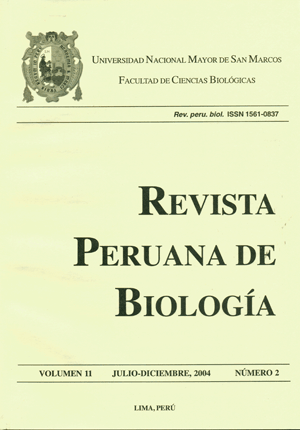Variants of mtDNA among islanders of the lake Titicaca: highest frequency of haplotype B1 and evidence of founder effect
DOI:
https://doi.org/10.15381/rpb.v11i2.2452Keywords:
mitochondrial DNA, Lake Titicaca islanders, haplotypes, RFLPAbstract
We analyzed mitochondrial DNA haplotypes from 144 samples of islanders of the Taquile and Amantani (Quechua speakers) and Los Uros and Anapia (Aymara speakers) of the Lake Titicaca, Peru. We have found the highest frequency of B1 mtDNA haplotype ever reported: 100% in Taquile (n= 57); 88,6% in Amantani (n= 35); 87,5% in Anapia (n= 24) and 75% in Los Uros (n= 28). There are other haplotypes but in low frequencies: 11,4% of C1 in Amantani; 17,9% of A2 and 7,1% of D1 in Los Uros; 4,2% of C1, C2 and D1 haplotypes in Anapia. The high frequency of the B1 haplotype indicates that Taquile, Amantaní and Anapia islands have been populated by a reduced founder group. Although the genetic affinity between islanders of Anapia and Los Uros, the proportion of some alleles in the latter suggest the persistence of the uru genetic background.Downloads
Downloads
Published
Issue
Section
License
Copyright (c) 2004 José Sandoval, Bedsabé Delgado, Luis Rivas, Bertha Bonilla, Daniel Nugent, Ricardo Fujita

This work is licensed under a Creative Commons Attribution-NonCommercial-ShareAlike 4.0 International License.
AUTHORS RETAIN THEIR RIGHTS:
a. Authors retain their trade mark rights and patent, and also on any process or procedure described in the article.
b. Authors retain their right to share, copy, distribute, perform and publicly communicate their article (eg, to place their article in an institutional repository or publish it in a book), with an acknowledgment of its initial publication in the Revista Peruana de Biologia.
c. Authors retain theirs right to make a subsequent publication of their work, to use the article or any part thereof (eg a compilation of his papers, lecture notes, thesis, or a book), always indicating its initial publication in the Revista Peruana de Biologia (the originator of the work, journal, volume, number and date).






